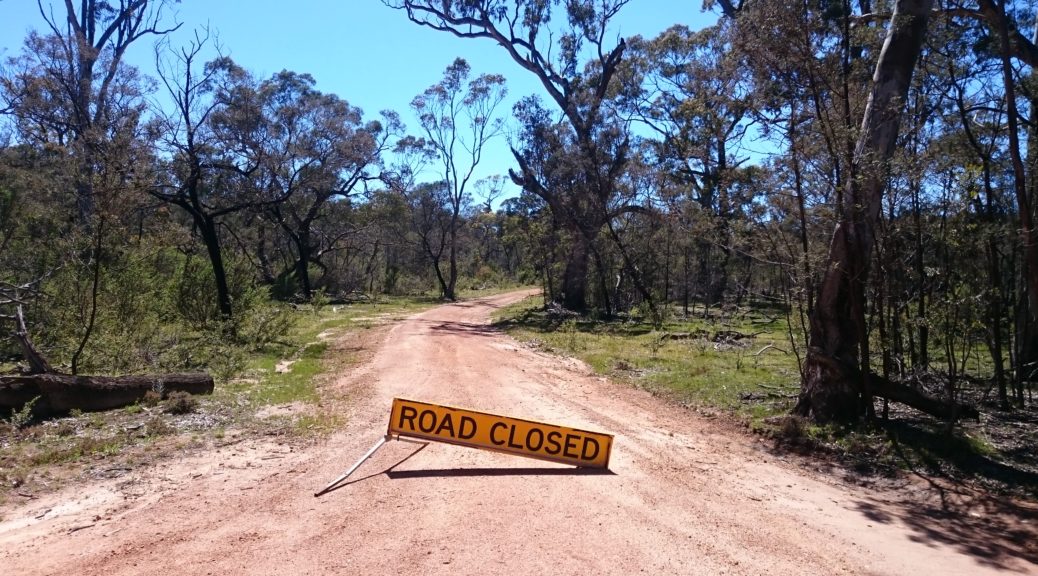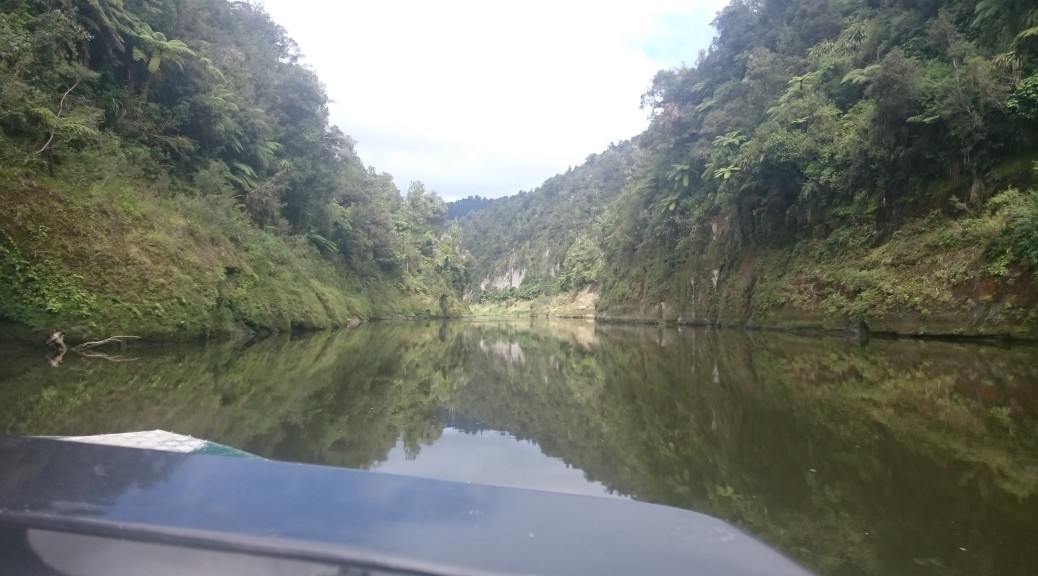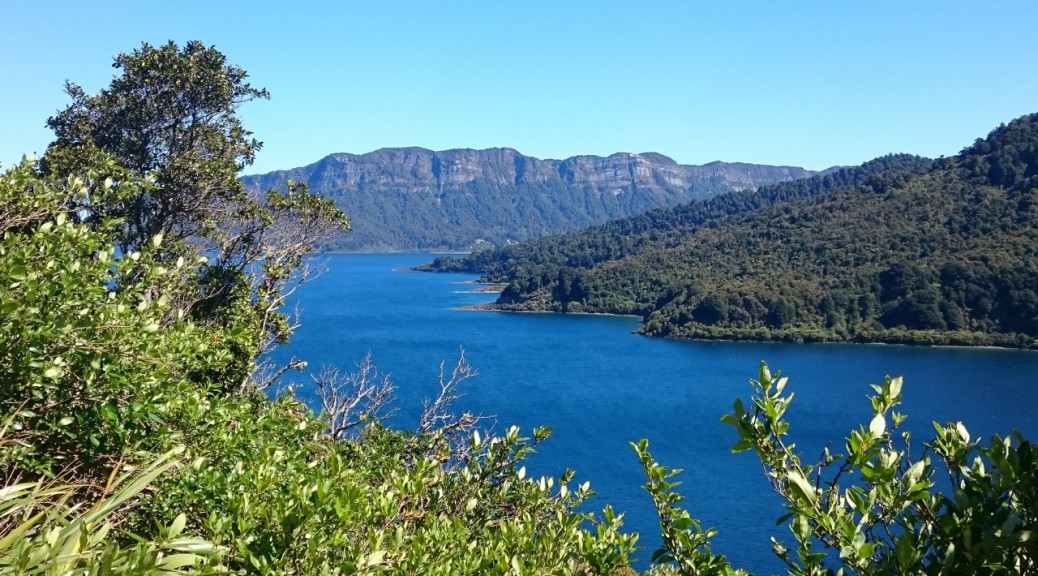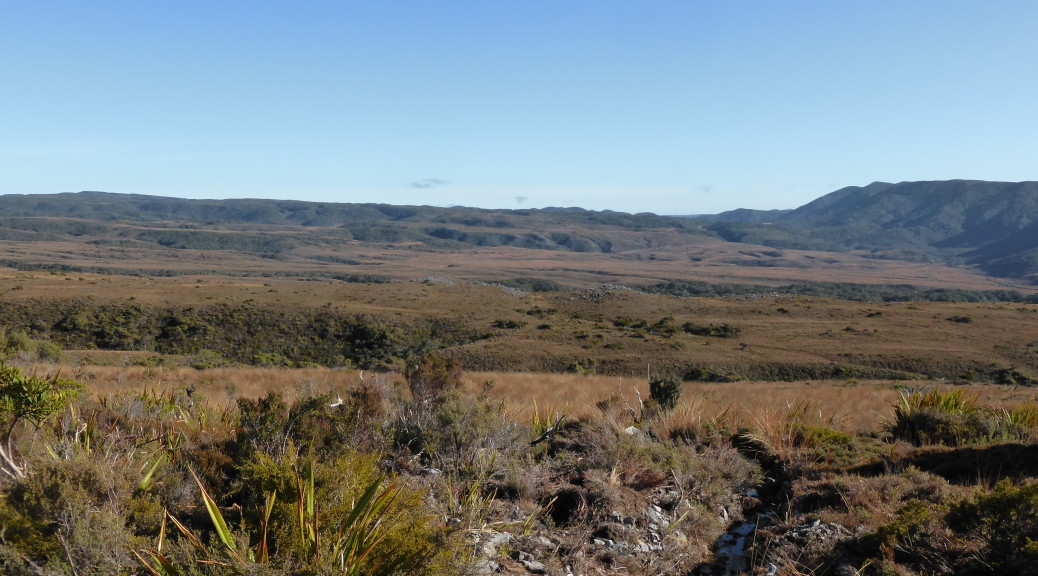I was excited to have a reason to drag myself out of the tent at dawn. It turned out to be worth getting up just to see the sun rise on the rock – the best light I saw all week.

I drove into Horsham to breakfast and get supplies for the day. I was horrified to discover that the first two bakeries I went to weren’t even open at seven o’clock! What kind of country is this? I had to resort to a chain bakery, as such my subsistence for the day was bread-heavy with little in the way of tasty fillings or toppings.
It took about an hour to get to the parking lot at Reed Lookout in Grampians National Park. On the slow, narrow windy road (by Australian standards, not so much NZ) the bush thickened as I left the plains and climbed. Up a hill! A very large deer leapt from nowhere and thoroughly put the wind up me as I avoided narrowly, through no emergency action on my part, the biggest scare I’ve had on the road in a long time. The day continued to brighten as forecast, but I was beginning to notice a bank of cloud behind the approaching ridge – where I was going.
Megan had provided inspiration for this ride, noticing that some of her friends had been on a gravel ride the weekend before. Before departing NZ I managed to contact the organiser of DirtyRat16 and get the GPS file and useful trail beta. Unfortunately Megan couldn’t source a suitable bike (there was little interest in the hardtail I’d seen seemingly abandoned on the edge of the Arapiles Big Sky Trail), so it was left to me selflessly to go and have a big day in the saddle, exploring solitarily.
I’d chosen a different start point of the DirtyRat16 loop to cut down on the driving. This was Reed Lookout, the parking lot was strangely busy with tourists at eight-ish in the morning. There wasn’t much to see however, as the entire valley was filled with cloud.
 Nothing to see hear folks, move along.
Nothing to see hear folks, move along.
But that was where I was going, so I set off climbing a little more on the road before turning off onto a dirt road. It wasn’t long before I came across a road-closure sign, which reminded me that the park had had an awful lot of rain recently and there was much related damage. I figured as the event had run this route ten days previously, I’d be OK. The gravel dumped me down to the valley floor, very quickly losing four hundred metres of elevation. At speed, under the cloud it was very chilly – but I knew the cloud would burn off eventually, so enjoyed the freshness while it lasted.
 The road widened for a while before I turned off.
The road widened for a while before I turned off.
 Onto another closed track, which narrowed, I startled many a kangaroo. They, sensibly, all bounded off away from me.
Onto another closed track, which narrowed, I startled many a kangaroo. They, sensibly, all bounded off away from me.
I’d been warned that the roughed-up Henham Trail had nearly finished off a few of the riders on the event – but suspected that was because they did it near the end of a big day. As it was, it was all rideable bar ten or twenty metres. There was signs of storm damage, particularly at the many creek crossing – but they were all negotiable.
 The roughest bit of the day & the only bit I ended up walking. There’s a bit of a climb there and the surface deteriorates half way up.
The roughest bit of the day & the only bit I ended up walking. There’s a bit of a climb there and the surface deteriorates half way up.
 Some of the creek crossing were fun to try and get across without dabbing. I soaked a foot in an earlier, deep, one – but as the cloud burned off this didn’t bother me.
Some of the creek crossing were fun to try and get across without dabbing. I soaked a foot in an earlier, deep, one – but as the cloud burned off this didn’t bother me.
 The hills that had been in the distance, steadily got closer.
The hills that had been in the distance, steadily got closer.
The nineteen kilometre track took me to the furtherest extremity of my loop, but only just over a third of the distance – the return took me west to the other side of the valley. I turned on to a road and it was much faster. I took to riding on the right side of the road to take advantage of the shade – and sometimes I like to pretend I’m in a country that drives on the right.
 Easy gravel road riding. Smooth, wide – & red!
Easy gravel road riding. Smooth, wide – & red!
The route turned off the road to another 4WD track, to thread between two hills over a slight saddle. To no one’s surprise it was closed, but easily passable on a bike.
 Just another sign to ride around.
Just another sign to ride around.
 I stopped for lunch where there was half a view, and finally decided it was warm enough to remove my gilet; sleeves stayed on as they are good sun protection and it still wasn’t hot. Perfect.
I stopped for lunch where there was half a view, and finally decided it was warm enough to remove my gilet; sleeves stayed on as they are good sun protection and it still wasn’t hot. Perfect.
The road north up the western side of the valley was also fast & easy going. I hadn’t seen anyone since that sole car early on. I was having a blast, but thought it might be more fun with some company to remark at various animals, trees and other sights. Maybe they’d have been able to educate me on the types of eucalyptus trees I was seeing – they all look very similar to me and I saw thousands of them. The washboard surface of the road became a little tiresome, but that’s a very minor complaint in the scheme of how good a time I was having.
 Even the swamp in the bottom of the valley, was looking good – I’m not sure if it had a castle or two lurking in the bottom.
Even the swamp in the bottom of the valley, was looking good – I’m not sure if it had a castle or two lurking in the bottom.
 Suddenly a water-logged airfield. The top of the hill on the left was my start and end point.
Suddenly a water-logged airfield. The top of the hill on the left was my start and end point.
After crossing the valley floor, I passed where I’d originally turned off the big dirt road and headed north through a camping area. About this time I started to startle pairs of emus. This was alarming as they are big, fast, have big pointy beaks, fearsome feet – and seem to be rather skittish, preferring to run back in front of an opposing threat rather than away from it. I was hoping I was big enough on my bike that they’d leave me alone.
 The only photo I managed to nab of an emu.
The only photo I managed to nab of an emu.
Through more closed track, where I actually had to lift my bike over a fallen tree – as opposed to riding around the dozens I’d encountered already – the only climb of the day began in earnest. Considering I had almost five hundred metres to gain, it was mostly gentle as the kilometres-to-go clicked down with moderate ascent.
 I took a small side-trip to some falls, reasoning that they might have water over them.
I took a small side-trip to some falls, reasoning that they might have water over them.
There was only one kicker in the climb, where a track back to the road quickly gained metres and I sweated my way up. Then back to the road for a little seal to Reed Lookout. It was a ninety-five kilometre gravel section – fantastic riding and an excellent route by Will. I was looking forward to seeing where I’d been now that the cloud had burnt off. I was not disappointed.
 I’d basically ridden from the bottom of the left of shot, towards the reservoir before continuing beyond it to the left, going between those two small hills and then heading back right on the other side of the reservoir.
I’d basically ridden from the bottom of the left of shot, towards the reservoir before continuing beyond it to the left, going between those two small hills and then heading back right on the other side of the reservoir.
 Following that, I came back towards the camera in this shot before heading around the spur in the centre and finally back up to the lookout.
Following that, I came back towards the camera in this shot before heading around the spur in the centre and finally back up to the lookout.
 And there are even some rocks.
And there are even some rocks.
I took some time to cool down, admire the view and load the bike in the car. Getting word the others were down in Halls Gap, I made haste to be slightly social, and refuel on salt & vinegar crisps and gelato. While I’d taken plenty of water, I’d eaten all my food and was peckish.
It was most definitely worth bringing my bike all the way to western Victoria for a well good loop of gravel and exploring unfamiliar lands.



 Found this where the track met the road/track in from Raetihi. Bike looking very lightly loaded as I’m wearing all my wet-weather gear.
Found this where the track met the road/track in from Raetihi. Bike looking very lightly loaded as I’m wearing all my wet-weather gear.
 Every so often there would be some sort of introduced flowering plant still surviving – the contrast was stark. Still quite a few non-native pines growing strongly.
Every so often there would be some sort of introduced flowering plant still surviving – the contrast was stark. Still quite a few non-native pines growing strongly. There were also many small signs with surnames displayed – remembering the families that had those particular plots. This simple method of memorial was quite poignant – as there really is very little left showing forty-odd families lived here.
There were also many small signs with surnames displayed – remembering the families that had those particular plots. This simple method of memorial was quite poignant – as there really is very little left showing forty-odd families lived here. Across the valley – there are many ferns there reclaiming the grassland.
Across the valley – there are many ferns there reclaiming the grassland. The riding was pretty easy, still heading down. There were quite a few bits where riders were advised to walk – but as they had nothing on the
The riding was pretty easy, still heading down. There were quite a few bits where riders were advised to walk – but as they had nothing on the  It was built to give better access for the families described above – to save them clambering up & down the valley walls. But by the time it was built they had the road (that I’d just ridden in on from the north) for access – so it was of little use and therefore little used as river access was no longer important.
It was built to give better access for the families described above – to save them clambering up & down the valley walls. But by the time it was built they had the road (that I’d just ridden in on from the north) for access – so it was of little use and therefore little used as river access was no longer important. My bike, a rock and quite a river.
My bike, a rock and quite a river. So it happened that I did get a ride on this boat – I think we had ten bikes and riders. I was pleased my bike didn’t go on a rack projecting out from the stern.
So it happened that I did get a ride on this boat – I think we had ten bikes and riders. I was pleased my bike didn’t go on a rack projecting out from the stern.

 Number plate shed caught my eye.
Number plate shed caught my eye.

 I was pleased to find classic Tip Top ice cream and Fanta advertisements on the side of a long-since-closed corner store in Frasertown.
I was pleased to find classic Tip Top ice cream and Fanta advertisements on the side of a long-since-closed corner store in Frasertown. I’m sure this sign is to warn off inexperienced gravel-road drivers and people who expect state highways in NZ to be up to a much higher standard than some (read: most) of them are. For the bikepacker, this serves to add to the anticipation for lightweight travel through remote places; I was well pleased to see this sign.
I’m sure this sign is to warn off inexperienced gravel-road drivers and people who expect state highways in NZ to be up to a much higher standard than some (read: most) of them are. For the bikepacker, this serves to add to the anticipation for lightweight travel through remote places; I was well pleased to see this sign. It was still all smiles as we had plenty of practice taking photos while riding along. This a particularly good one of Steven’s thumb, and for a change I make a photographic appearance in my own blog.
It was still all smiles as we had plenty of practice taking photos while riding along. This a particularly good one of Steven’s thumb, and for a change I make a photographic appearance in my own blog. Taking a slight detour off the highway, we began a little side-tour; that of the Waikaremoana Hydro Power Scheme. This the lowest of three small power stations linked together, all using water flowing from the Lake Waikaremoana.
Taking a slight detour off the highway, we began a little side-tour; that of the Waikaremoana Hydro Power Scheme. This the lowest of three small power stations linked together, all using water flowing from the Lake Waikaremoana. Riding across the dam of the hydro lake at Tuai – the power station in the distance. Most of our riding was now surrounded by either water or vast expanses of native bush.
Riding across the dam of the hydro lake at Tuai – the power station in the distance. Most of our riding was now surrounded by either water or vast expanses of native bush.
 First swim stop of the day for Steve.
First swim stop of the day for Steve. As is quite common, a small town (large village, really) was to be found near this hydro power scheme. This one, Tuai, obviously built for the construction of the dams & powerhouses and still looking in really good condition. Just a representative house that I happened to snap while riding past.
As is quite common, a small town (large village, really) was to be found near this hydro power scheme. This one, Tuai, obviously built for the construction of the dams & powerhouses and still looking in really good condition. Just a representative house that I happened to snap while riding past. We rejoined the highway and the climbing continued, but never steeply. Here we look back down to Tuai.
We rejoined the highway and the climbing continued, but never steeply. Here we look back down to Tuai. We lost a bit of altitude taking another detour to the third power station, Kaitawa. These penstocks bring water down from Lake Waikaremoana after it’s travelled through a tunnel. It was at this point Steve suggested we should ride up there as a shortcut; I suggested he go jump in the lake while I had first-lunch.
We lost a bit of altitude taking another detour to the third power station, Kaitawa. These penstocks bring water down from Lake Waikaremoana after it’s travelled through a tunnel. It was at this point Steve suggested we should ride up there as a shortcut; I suggested he go jump in the lake while I had first-lunch. A rather reflective sign about the power scheme: in case anyone still cares and so I can stop banging on about it so much.
A rather reflective sign about the power scheme: in case anyone still cares and so I can stop banging on about it so much.
 Quite picturesque really, despite the infrastructure. We set off on a short walk around the lake, but it never opened up and gave us good access to or views of the lake. So we turned back.
Quite picturesque really, despite the infrastructure. We set off on a short walk around the lake, but it never opened up and gave us good access to or views of the lake. So we turned back. Steve did take that second swim, while I enjoyed my bacon & egg pie from Osler’s. Only when he tried to get out of the tailrace, did Steve realise the walls were really quite high.
Steve did take that second swim, while I enjoyed my bacon & egg pie from Osler’s. Only when he tried to get out of the tailrace, did Steve realise the walls were really quite high. We did make it up the access road beside the penstocks – it did save a bit of backtracking distance and in our granny gears the 20+% gradient was OK.
We did make it up the access road beside the penstocks – it did save a bit of backtracking distance and in our granny gears the 20+% gradient was OK. Finally, more of Panekire Bluffs came into view – much as I remember them from
Finally, more of Panekire Bluffs came into view – much as I remember them from  Once again it proved impossible to keep Steve out of the water – just a swim across Home Bay & back this time, about a mile. I sat under a tree and enjoyed the $80/kg pastrami from the store at the campground.
Once again it proved impossible to keep Steve out of the water – just a swim across Home Bay & back this time, about a mile. I sat under a tree and enjoyed the $80/kg pastrami from the store at the campground. When we rode over the bridge atop Mokau Falls, we didn’t even realise they were there – let alone, that they looked like this.
When we rode over the bridge atop Mokau Falls, we didn’t even realise they were there – let alone, that they looked like this. This was our final view of Panekire Bluffs, perhaps the best yet.
This was our final view of Panekire Bluffs, perhaps the best yet. We’d heard much of wild horses all over the road once over the saddle. Here, our first sighting; also memorable as just past all those cars was our first being-chased-by-a-fierce-dog experience of the trip (something else we’d also be warned about).
We’d heard much of wild horses all over the road once over the saddle. Here, our first sighting; also memorable as just past all those cars was our first being-chased-by-a-fierce-dog experience of the trip (something else we’d also be warned about). Our set-up for the evening, I probably should have been not still sitting down.
Our set-up for the evening, I probably should have been not still sitting down.
 We even had blue ducks visit our campsite! An endangered species native to NZ, they feature on our ten dollar note/bill and I don’t think I’ve ever seen one before. Fortuitously, we didn’t even have to go searching for them, as they can be hard to find (obviously, they’re endangered & therefore rare) – they came to us.
We even had blue ducks visit our campsite! An endangered species native to NZ, they feature on our ten dollar note/bill and I don’t think I’ve ever seen one before. Fortuitously, we didn’t even have to go searching for them, as they can be hard to find (obviously, they’re endangered & therefore rare) – they came to us. A few of the locals dropped in for an evening graze.
A few of the locals dropped in for an evening graze.
 The steelwork of destroyed picnic tables makes for great bike-stands; here at the highest point of the second day – looking back over the Ureweras.
The steelwork of destroyed picnic tables makes for great bike-stands; here at the highest point of the second day – looking back over the Ureweras. We stopped at this old service station shortly before Murupara to fill water bottles – we’d been warned about the dogs in town, so avoided that.
We stopped at this old service station shortly before Murupara to fill water bottles – we’d been warned about the dogs in town, so avoided that. It was strange seeing Mt Tarawera looming up from a different angle – but all the same, there it was.
It was strange seeing Mt Tarawera looming up from a different angle – but all the same, there it was.

 This was a different view from the hut compared to last time – a lot less distant cloud and more snow.
This was a different view from the hut compared to last time – a lot less distant cloud and more snow.



 The rivers were crystal clear, but on such a chilly morning not at all inviting.
The rivers were crystal clear, but on such a chilly morning not at all inviting. The wet trail glinting in the early-afternoon sun before the slippery descent onto Gouland Downs.
The wet trail glinting in the early-afternoon sun before the slippery descent onto Gouland Downs. Looking out over the downs.
Looking out over the downs. As James pointed out, sections of the bush looked a little like giant bonsai trees.
As James pointed out, sections of the bush looked a little like giant bonsai trees. A rather pretty little stream.
A rather pretty little stream. I finally bothered to get a photo of one of these signs – the likes of which I’ve never seen on a mountain-bike trail before.
I finally bothered to get a photo of one of these signs – the likes of which I’ve never seen on a mountain-bike trail before.